As an ecommerce entrepreneur doing SEO, you may have already optimized various aspects of your online store, like your product descriptions or images. However, your work is incomplete until you nail the meta description of your web pages.
Meta descriptions are crucial for on-page SEO, so it’s important to optimize them for both readers and search engines. Below, we explain how meta descriptions work, and provide a guide to writing meta descriptions that’ll help your online store succeed.
At the end of this post, you’ll be equipped with all the SEO knowledge you need to create your own compelling meta descriptions.
Let’s get started.
What is a Meta Description?
A meta description is a snippet of text that summarizes a page’s content in up to 160 characters. You’ll likely have seen meta descriptions before when you’ve used a search engine like Google.
Whenever you enter a search query into Google, you’ll be presented with a SERP (Search Engine Results Page). On this SERP you’ll find various results that are related to your search query. Below, we’ve placed an image which shows an excerpt from a SERP for 'Shopify'.
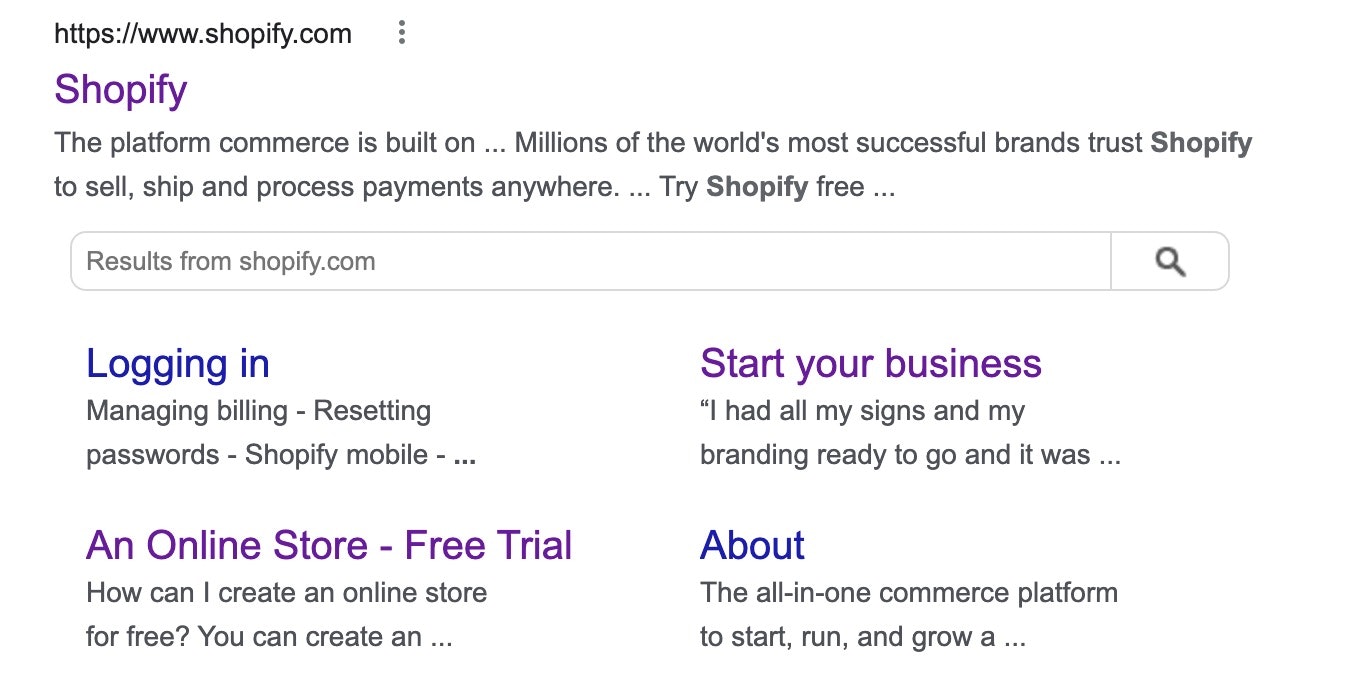
Here, you’ll find that there are two main features to note. First is the blue text that you see in the image above, which is known as the ‘Title Tag’. The function of the Title Tag is to show the title of the page. Below this you’ll find the meta description, which has a simple function — to draw visitors from the search engines to click on your link.
How Long Should a Meta Description Be?
The ideal meta description length is 155-160 characters. Although there’s no penalty for going above 160 characters, search engines typically limit snippets to the mentioned character range. You can use a tool like www.charactercountonline.com to keep a count of your meta description characters.



Why are Meta Descriptions Important?
As a store owner, you’ll want to do everything in your power to get your products into the view of potential customers. Meta descriptions help you to raise your clickthrough rate from three main sources — search engine results, social media shares, and social bookmarks. In all three of these sources, a meta description can provide more information about the page, and help you to secure the attention of a reader.
Although search engines have confirmed that they don’t use meta descriptions in the ranking algorithm directly, Google does use a page’s CTR (Click Through Rate) to assess how well your webpage fits the search query. As meta descriptions really help you to increase the CTR of your web page, they’re a great way to increase your Google ranking.
→ Click Here to Launch Your Online Business with Shopify
When you have a higher ranking on Google, you’ll be getting more visitors. More visitors to your store means more potential customers, which means you’ve also got a higher chance of making sales. After all, there are over one billion monthly active users on Google!
How to Write a Good Meta Description
Now that we’ve covered the function of a meta description, it’s time that we explained how to write a meta description that’ll boost the traffic that your online store receives.
It’s important to note that there are some differences between meta descriptions for a home page, and for product pages. We’ve created a simple guide to creating meta descriptions for both home pages and product pages below:
Creating a Homepage Meta Description
When you’re writing a meta description for your homepage, you’ll need to convey the overall message of your business in just 160 characters. This is certainly a difficult task, even if you are an experienced writer.
As a general rule, it’s always a good idea to maintain simple meta descriptions, whilst coming up with a compelling reason to click on the page. When your potential customers are using Google, they won’t even realise why they’ve made a decision — they’ll simply see your compelling meta description copy and then click on the link.
Here’s a great example for a homepage meta description:
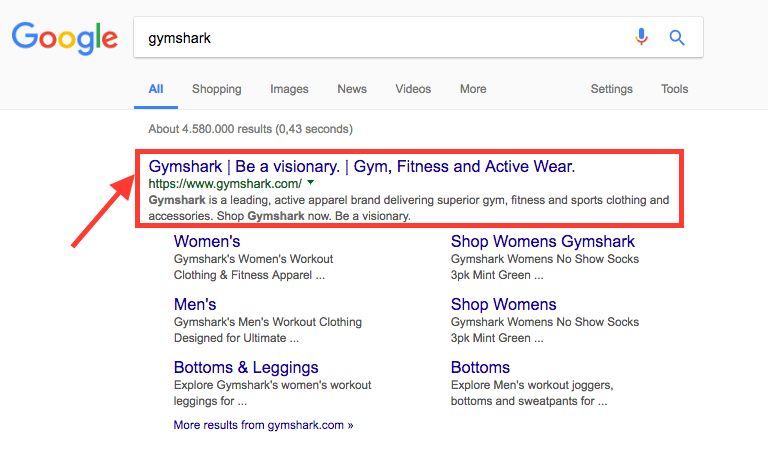
Gymshark has created a meta description which sums up their brand’s vision in just 15 words. It’s short, snappy, and relevant to their audience.
If, like Gymshark, you can summarize your brand in less than 160 characters, you can also use a CTA (Call To Action). Gymshark uses ‘Shop Gymshark now’ as a direct command to the audience, which will entice traffic to their store.
Plus, the brand uses aspirational language like ‘be a visionary’ to communicate directly with potential customers.
Creating a Product Page Meta Description
Optimizing product page meta description is slightly different from creating a home page meta description.
Instead of conveying your brand’s vision in just 160 characters, you’ll need to alert potential customers about the benefits that they’ll receive if they click on your product page.
It’s a great idea to include the unique selling points of your product in the meta description, as this is most likely to draw in potential customers.
Here’s a great example of a product page meta description below:

Here you can see a great meta description for Myprotein’s protein bar product page. Immediately you’ll see the product, and the keyword, has been mentioned — this is great for SEO purposes. Straight after this you’ll find the benefit that you’ll get if you choose these protein bars. They’re described as a ‘convenient nutritional snack’ which is exactly what somebody searching for protein bars is looking for.
You’ll also find at the end of their meta description they have written ‘an unrivaled range of bars, cookies and …’, as the list is incomplete, potential customers are likely to visit the page to find out the missing information.
Whether you’re writing a meta description for your store’s home page, or a best-selling product page, you’ll be able to use these examples as inspiration.
How to Adjust SEO Meta Description in Shopify?
If you’re running your store with Shopify, you can adjust your meta descriptions from your Shopify settings. You can access this from your Sales Channel, clicking on Pages, and then using ‘Edit Website SEO’.
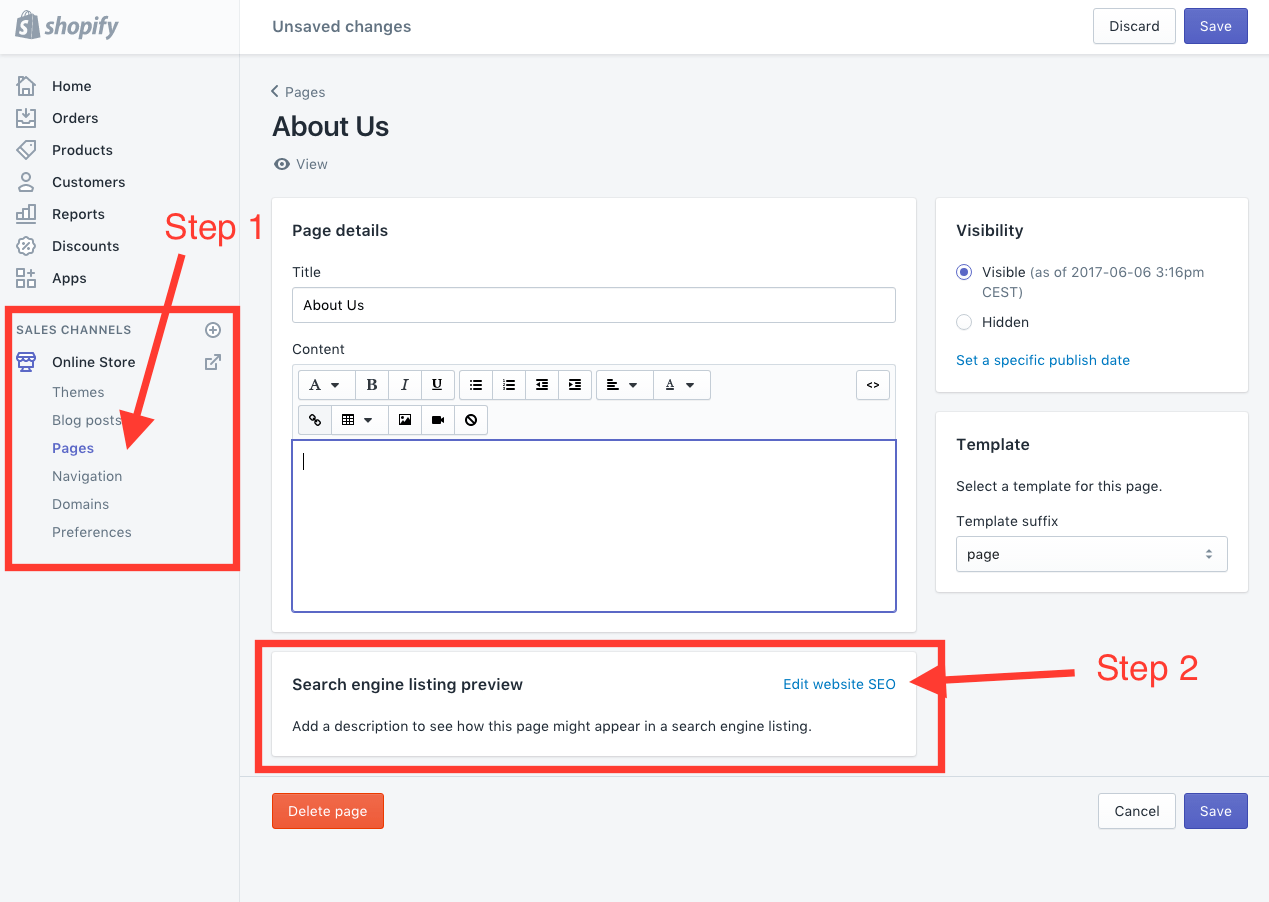
Important note: If you haven’t yet created meta descriptions for your web pages, don’t worry — Google automatically creates one for each page.
A Word on Google Meta Descriptions
Meta descriptions that have been curated by Google’s algorithm will simply display text that is already on your page. Whilst using these automatically generated meta descriptions is sufficient, it’s your job as an ecommerce entrepreneur to make sure that your store stands out from the crowd. Create your own meta descriptions and you’ll be able to increase your CTR and further optimize that page for a specific keyword.
Meta Description Preview Tools
A meta description preview tool enables you to view what your link will look like on a SERP before you publish the page. If you’re looking to bolster your webpage’s SEO, these tools are essential. Here are a few free meta description preview tools which you can use to perfect your website meta description.
Portent
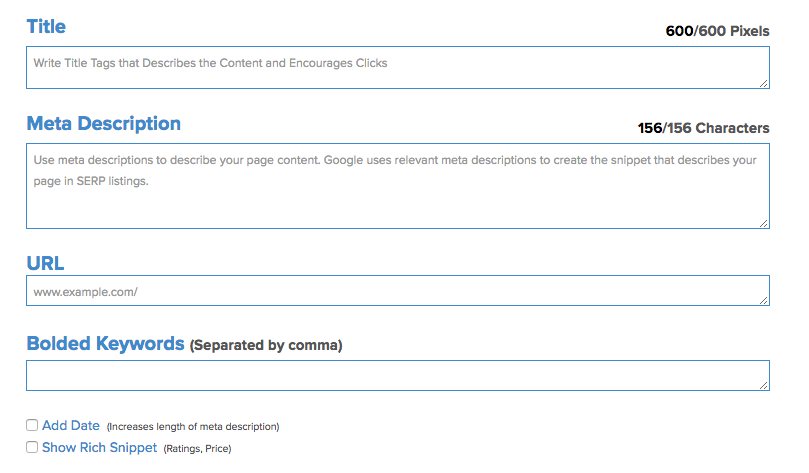
Portent has created a simple meta description preview tool which you can easily use to practice and perfect your page’s meta descriptions. When you use this tool, you’ll need to enter the title tag, meta description, URL, and any keywords that you’re looking to optimize. Once you’ve provided this information, you’ll be given a view of how the page looks on a SERP.
ToTheWeb
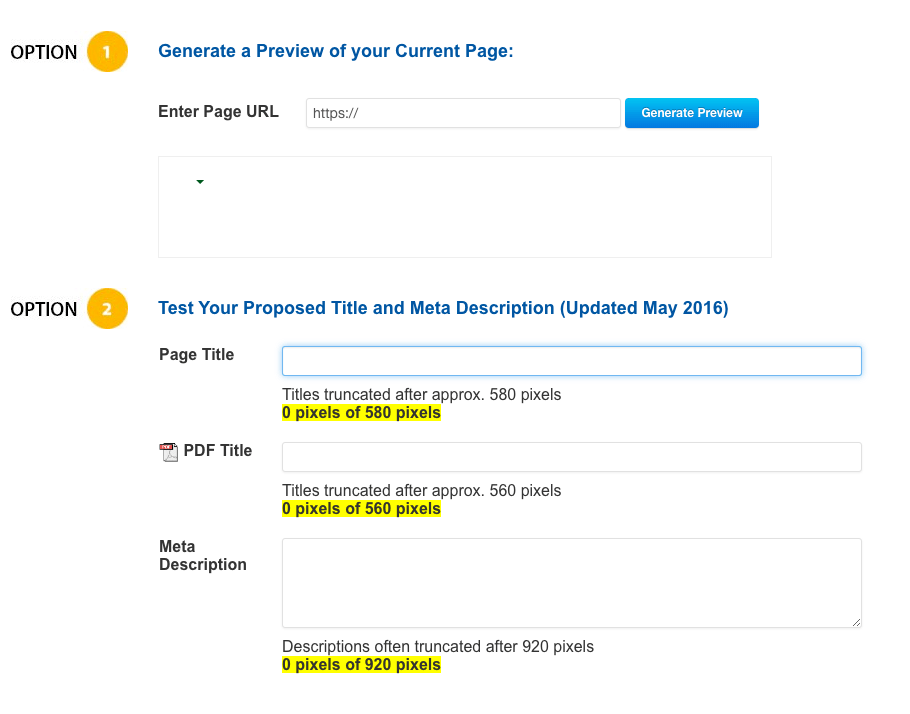
ToTheWeb’s meta description preview tool has two functions, both of which are fantastic for an ecommerce entrepreneur. The first function allows you to enter your page’s URL and you’ll then be provided with an outlook of how the page appears on a SERP. The second function of the tool is a meta description editor — you can use this to edit and optimize your page’s meta description. Once you’ve landed on a killer meta description, you can update your page and reap the benefits.
Creating Mobile Optimized Meta Descriptions
When you’re optimizing an onlines store for search engines, it’s critical that you take into account mobile audiences. It’s estimated that around 69% of all internet users use mobile for product research, and that figure is only going to go up in the future.
It’s a great idea to bare this in mind when you’re creating meta descriptions for your pages. We recommend that you use Yoast when creating your meta descriptions — they have incorporated buttons on their tool which allow you to switch between mobile and desktop meta descriptions.

When you’re creating meta descriptions for a mobile audience try to ensure that your title tags are kept within 40-60 characters, and that your meta descriptions are less than 90 characters long. The reason for this is that there are fewer characters displayed on a mobile SERP, as the screen sizes are also smaller.
6 Tips for Optimizing Your Meta Description and CTR
Now you’re ready to start creating your own meta descriptions — congratulations!
It doesn’t matter if you’re already a skilled SEO writer, or if it’s your first time optimizing a web page, you’ll learn the best writing techniques as you’re creating your own meta descriptions. Just before you dive into meta descriptions yourself, we’ve created a list of 6 tips that’ll help you to optimize your meta descriptions, and increase the CTR for your store:
1. Answer the User’s Question
People use search engines like Google to find answers. It doesn’t matter if the question that they’re asking is ‘is Berlin hot in Summer?”, or “how to become rich with dropshipping?” — if you can answer the user’s question in your meta descriptions, you’ll be able to entice intrigued readers to click on your content.
2. Ensure Your Meta Descriptions Are Relevant
When you’re writing a meta description, it’s imperative that the copy is relevant to not only the Title Tag, but that it’s also relevant to the search term that user is interested in. If you’re selling sunglasses and your meta description includes information about handbags, your audience will be confused and unlikely to click on your page.
3. Drive Home Your Message
60 characters really isn’t a lot to work with when you’re writing a meta description. Once you’ve decided on the messaging that you want to use, try to include it as much as you can in the character limit. Every word should be there for a reason, and that reason should be to improve your CTR.
4. Create Enticing Meta Tag Copy
Studies show that 8 out of 10 users will click on your page if you have a compelling copy. Take advantage of this information and create the best page titles that you can — it’ll really help your store to generate and secure traffic.
5. Take Advantage of CTAs
It’s a great idea to include a CTA (Call To Action) in your meta description. A CTA like ‘buy now’ is a direct command that may inspire your users to take action and purchase a product from your store.
6. Use the Active Voice
It’s always best to use the active voice when you’re writing your meta descriptions. Instead of using language like, “All the best styles are found here”, use “Find all the best styles”. This presents a command to potential customers, instead of a suggestion.
Summary: How to Write a Good Meta Description in 2021
Now you’re ready to write great meta descriptions for your online store! You’ll be able to use the tips and tricks mentioned in this article to start generating even more organic traffic to your ecommerce store today.
In summary, here are all the steps to writing good meta descriptions:
- Answer questions through your description
- Ensure your he meta description copy is relevant to search intent
- Make full use of meta description length
- Use enticing copy for your meta description tag
- Take advantage of call-to-actions
- Write in an active voice
If you have any more questions about meta descriptions, or ecommerce businesses in general, let us know in the comments section below — we’re happy to help you on your entrepreneurial journey.






